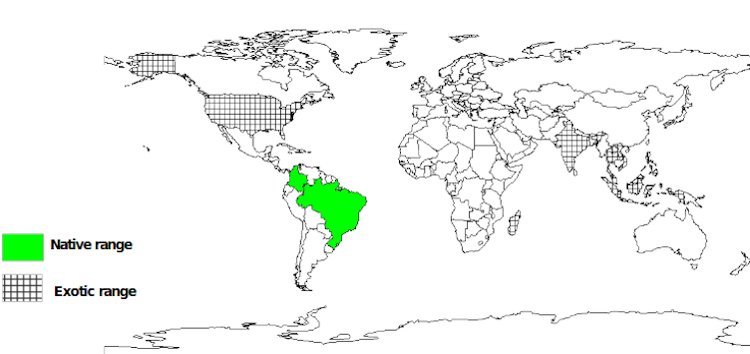Publication
from Agroforestree Database: a tree reference and selection guide
version 4.0
by C. Orwa, A. Mutua, R. Kindt, R. Jamnadass and S. Anthony
Phyllanthus
acidus (L.) Skeels
Local Names:
Burmese
(thinbozihpyoo); English (country gooseberry, star gooseberry, plum,
Otaheite gooseberry,damsel, Malay gooseberry); Filipino (karmay,
bangkiling, iba); French (cerisier de Tahiti); Indonesian (cerme,
ceremai, caramele); Lao (Sino-Tibetan) (mak nhom, nhom baanz, nhom
ban); Malay (kemangul, chermala, chermai); Spanish (grosella); Thai (ma
rom); Vietnamese (t[aaf]m ru[ooj]t, ch[uf]m ru[ooj]t)
Family:
Euphorbiaceae
Botanic
Description
Phyllanthus
acidus is a
small, glabrous tree up to 10 m tall with phyllanthoid branching, bark
rough, grey, with prominent lenticels; cataphylls not persistent,
blackish-brown, their stipules triangular-ovate; deciduous branchlets
ascending, (20-)25-52 cm long, with 25-40 leaves.
Leaves
pinnate, 20-40 cm long. Leaflets alternate, simple, entire, shortly
petiolate, broadly ovate to ovate-lanceolate, (4-)5-9 cm x (2-)2.5-4.5
cm, base obtuse to rounded, apex acute, petiole 2.5-4 mm long, stipules
triangular-acuminate.
Flowers small, pink, in dense,
cushion-shaped cymules at the nodes of leafless branches on older wood,
and usually also on proximal branchlets of current year’s growth, pale
green to reddish; male flowers 4-merous, filaments and anthers free,
dehiscing vertically; female flowers on a stout pedicel, 4-merous, disk
deeply lobed or split, styles connate, deeply bifid, staminodes
present, ovary superior.
Fruit drupaceous, oblate, 1-1.5 cm x
(1.2-)1.5-2(-2.5) cm when fresh, shallowly 6- or 8-lobed, greenish
yellow to creamy-white; flesh firm, sour with a hard, bony, grooved
stone containing 6-8 smooth seeds.
Phyllanthus, the generic name
is derived from the Greek ‘phullon’-leaf and ‘anthos’-flowers from the
fact that members of this genus have flowers in dense clusters in leaf
axils.
Biology
Otaheiti gooseberry is monoecious. Flowering and fruiting is mostly in
January-May in the Caribbean and throughout the year in Java. The tree
flowers between February-April in Florida. Fruits mature in 90-100
days. P. acidus
trees start producing a substantial crop at the age of 4 years. The
peak fruiting season in the Philippines is in April to June. The fruits
often explosively dehisce dispersing their seeds.
Ecology
Otaheiti gooseberry grows well in the tropics at low and medium
altitudes in places with a short or prolonged dry season. The tree
prefers hot, humid tropical lowlands. In north-eastern Brazil, the tree
has been found in coastal forest and in Southeast Asia it is cultivated
on humid sites, up to 1 000 m altitude.
Biophysical
Limits
Altitude: 0-1 000 m
Soil types: It tolerates a variety of soils including very sandy soils
Documented
Species Distribution
Native:
Brazil, Colombia
Exotic: India, Indonesia, Laos, Madagascar, Malaysia,
Myanmar, Philippines, Thailand, US, Vietnam, Zanzibar

The
map above shows countries where the species has been planted. It does
neither suggest that the species can be planted in every ecological
zone within that country, nor that the species can not be planted in
other countries than those depicted. Since some tree species are
invasive, you need to follow biosafety procedures that apply to your
planting site.
Products
Food:
The mature sour fruits may be eaten fresh but usually they are
sprinkled with salt to neutralize the acidity. Used in cooking to
flavor dishes, the fruits are excellent raw materials for processing
into pickle and sweetened dried fruits; fruit juice is used in cold
drinks and fruit to make vinegar. In Malaysia, ripe and unripe fruit
are served as a relish, syrup or sweet preserve. The fruits, combined
with other fruits are used in chutney or jam, because of their setting
properties. Young leaves are cooked as a vegetable in Indonesia,
Thailand and India.
Fuel:
The tree is used as fuelwood.
Timber:
The wood is fairly hard, strong, tough and durable if seasoned. It is
used for utensils and other small objects.
Tannin or
dyestuff: The bark is used in India as a tanning agent.
Poison: Extract from the plant has shown nematicidal
activity against the pine wood nematode, Bursaphelenchus xylophilus.
The juice of the root bark is weakly poisonous.
Medicine: The latex is credited with emetic and purgative
activity. In Indonesia the bark is heated with coconut oil and spread
on eruptions on feet and hands. An infusion of the root is taken to
alleviate asthma in Java. In Borneo, roots are used in the treatment of
psoriosis of the feet. A leaf decoction is applied to urticaria, a
decoction of the bark is used to treat bronchial catarrh in
Philippines. The fruit is used as a laxative in Myanmar. In India, the
fruits are taken as a liver tonic to enrich the blood.
Other products:
Triterpenoids (phyllanthol and ?-amyrin) have been isolated from the
Otaheiti gooseberry. The root bark contains saponins, gallic acid and
tannins.
Tree
Management
It is grown at a spacing of 8 m x 8 m in Indonesia.
Pests and
Diseases
Caterpillars of Parallelia
absentimacula and P.
joviana feed on the cerme in Indonesia. The only serious
pest is the oriental fruitfly (Dacus
dorsalis) which infests maturing fruits.
Further
Reading
Mackeen MM et al. 1997. Antinematodal activity of some Malaysian plant
extracts against the pine wood nematode, Bursaphelenchus xylophilus.
Pesticide Science. 51(2): 165-170.
Nafus D and Schreiner I. 1991. Oviposition by herbivorous insects on
spider webs as an anti-predation defence. Ecological Entomology. 16(4):
513-517.
Prasad D. 1986. Edible fruits and vegetables of the English speaking
Caribbean. Caribbean Food and Nutrition Institute. Kingston, Jamaica.
Pushpakumara DKNG. 2007. Chapter 21: Rata nelli Phyllanthus acidus
L.: In: Pushpakumara DKNG, Gunasena HPM,
Singh VP. 2007 eds. Underutilized fruit trees in Sri Lanka. World
Agroforestry Centre, South Asia Office, New Delhi, India. p. 486-494.
Rizk AFM. 1987. The chemical constituents and economic plants of the
Euphorbiaceae. Botanical Journal of the Linnean Society. 94(1-2):
293-326
|
|
